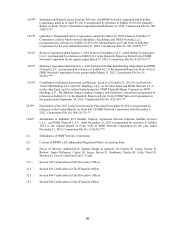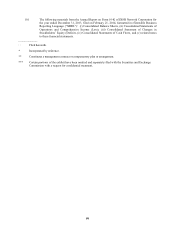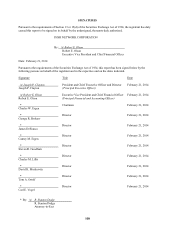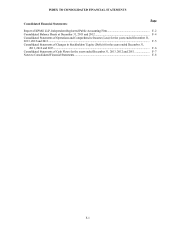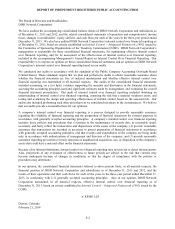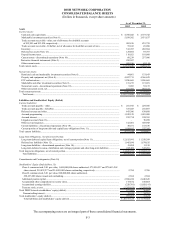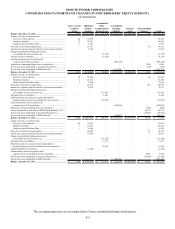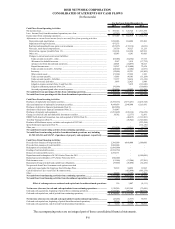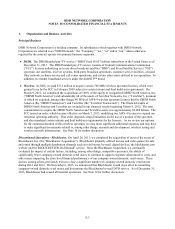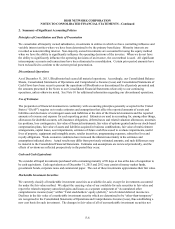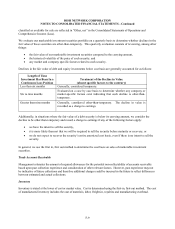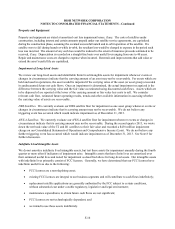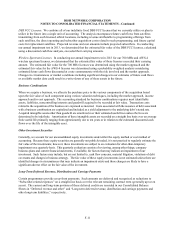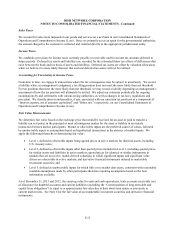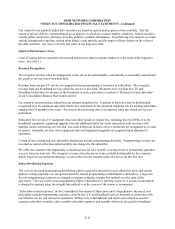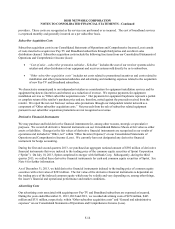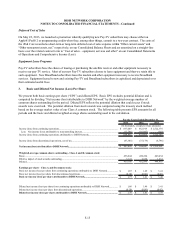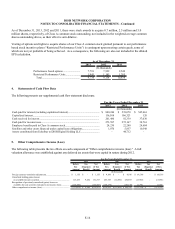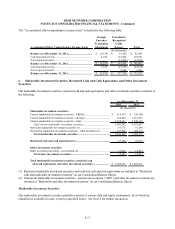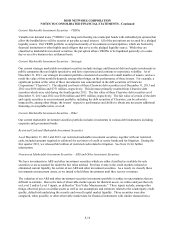Dish Network 2013 Annual Report Download - page 118
Download and view the complete annual report
Please find page 118 of the 2013 Dish Network annual report below. You can navigate through the pages in the report by either clicking on the pages listed below, or by using the keyword search tool below to find specific information within the annual report.DISH NETWORK CORPORATION
NOTES TO CONSOLIDATED FINANCIAL STATEMENTS - Continued
F-8
2. Summary of Significant Accounting Policies
Principles of Consolidation and Basis of Presentation
We consolidate all majority owned subsidiaries, investments in entities in which we have controlling influence and
variable interest entities where we have been determined to be the primary beneficiary. Minority interests are
recorded as noncontrolling interest. Non-majority owned investments are accounted for using the equity method
when we have the ability to significantly influence the operating decisions of the investee. When we do not have
the ability to significantly influence the operating decisions of an investee, the cost method is used. All significant
intercompany accounts and transactions have been eliminated in consolidation. Certain prior period amounts have
been reclassified to conform to the current period presentation.
Discontinued Operations
As of December 31, 2013, Blockbuster had ceased all material operations. Accordingly, our Consolidated Balance
Sheets, Consolidated Statements of Operations and Comprehensive Income (Loss) and Consolidated Statements of
Cash Flows have been recast to present the operations of Blockbuster as discontinued for all periods presented and
the amounts presented in the Notes to our Consolidated Financial Statements relate only to our continuing
operations, unless otherwise noted. See Note 10 for additional information regarding our discontinued operations.
Use of Estimates
The preparation of financial statements in conformity with accounting principles generally accepted in the United
States (“GAAP”) requires us to make estimates and assumptions that affect the reported amounts of assets and
liabilities and disclosure of contingent assets and liabilities at the date of the financial statements and the reported
amounts of revenue and expense for each reporting period. Estimates are used in accounting for, among other things,
allowances for doubtful accounts, self-insurance obligations, deferred taxes and related valuation allowances, uncertain
tax positions, loss contingencies, fair value of financial instruments, fair value of options granted under our stock-based
compensation plans, fair value of assets and liabilities acquired in business combinations, fair value of multi-element
arrangements, capital leases, asset impairments, estimates of future cash flows used to evaluate impairments, useful
lives of property, equipment and intangible assets, retailer incentives, programming expenses, subscriber lives and
royalty obligations. Weak economic conditions have increased the inherent uncertainty in the estimates and
assumptions indicated above. Actual results may differ from previously estimated amounts, and such differences may
be material to the Consolidated Financial Statements. Estimates and assumptions are reviewed periodically, and the
effects of revisions are reflected prospectively in the period they occur.
Cash and Cash Equivalents
We consider all liquid investments purchased with a remaining maturity of 90 days or less at the date of acquisition to
be cash equivalents. Cash equivalents as of December 31, 2013 and 2012 may consist of money market funds,
government bonds, corporate notes and commercial paper. The cost of these investments approximates their fair value.
Marketable Investment Securities
We currently classify all marketable investment securities as available-for-sale, except for investments accounted
for under the fair value method. We adjust the carrying value of our available-for-sale securities to fair value and
report the related temporary unrealized gains and losses as a separate component of “Accumulated other
comprehensive income (loss)” within “Total stockholders’ equity (deficit),” net of related deferred income tax.
Declines in the fair value of a marketable investment security which are determined to be “other-than-temporary”
are recognized in the Consolidated Statements of Operations and Comprehensive Income (Loss), thus establishing a
new cost basis for such investment. The changes in fair value of all of our marketable investment securities not


